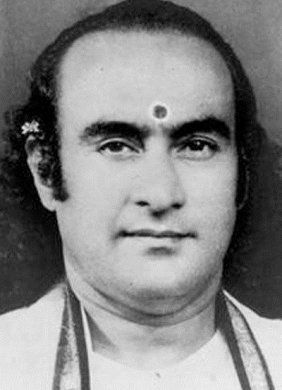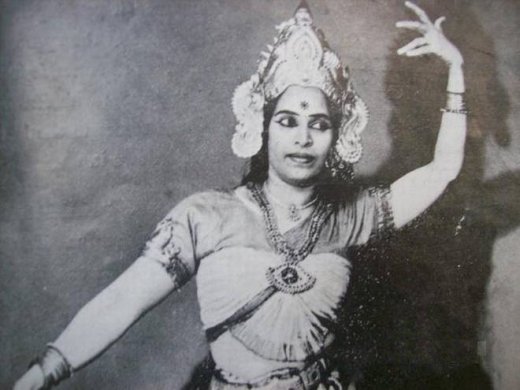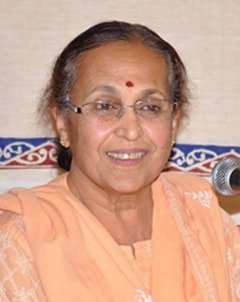
|
 |

|
 |
Labeling Guru Gopinath's dance style - Vasanti Gopinath Jayaswal e-mail: vasanti.jayaswal@gmail.com July 26, 2021 This writer had the good fortune of being a student of Natana Niketan in Madras founded by Guru Gopinath and Thankamani from 1950 to 1962. Teacher Thankamani was my first guru, as beginners were always handled by her. After being trained under her for two years, we graduated to Guruji's class. Thanks to being under him for so many years, his creative and beautiful style has been embedded in me forever. It is indeed very painful to see a distorted version of a dance form that claims to be Guruji's style. Guruji's path-breaking items like the Peacock dance, Saree dance, Harvest dance, to name a few, have enriched me greatly. He was always interested in composing dances to contemporary and secular themes and did not confine himself to the narrow boundaries of mythology alone. Together with Guruji and the entire team, once we had enacted the trauma of people caught in a flood. I remember the tumultuous applause we received for this work. Etched in my memory is the dance drama 'Natir Puja' by Rabindranath Tagore composed by Guruji during the poet's centenary. I was glad to be in the role of Srimati, a devotee of the Buddha who faced death for flouting the order of Samrat Ajatasatru not to offer prayers to the Buddha. As a direct disciple of Guru Gopinath and Thankamani amma, I fully concur with the opinion of my fellow disciple and daughter of Guruji, Vasanti Jayaswal. Guruji extended the boundaries of tradition in the early years of the 20th century. He taught a contemporary style which was classical in form. What goes in the name of Kerala Natanam does not qualify to be Guruji's Oriental Style of dance. - Tapati Chowdurie (tapatichow@yahoo.co.in)  Guru Gopinath  Thankamani Gopinath Lately, during these stagnant Covid times I have seen on YouTube, videos of classes and dance routines, labeled as Guru Gopinath's Kerala Natanam. They have modified it and sadly added Kuchipudi and Bharatanatyam in the stances and movement patterns. It is important for the current public and art enthusiasts therefore to know the following facts. I have itemized them for better understanding. 1. His first name was Govindan. Later he himself took on the artistic name of Gopinath. Guruji was never interested in giving a particular name to the artistic work of his life. Such names as Oriental Dances, Dance Ballet were used to describe his program announcements. Much later in his life he allowed a few insistent senior students to call his style Kerala Natanam. Eventually participants ended learning a routine or two to enter Kerala's controversial and notorious Youth Festivals under this category. 2. What will modern proponents of so called pure Kerala Natanam have to say, to such items as Harvest dance, Natir Puja, Chokkan and Veeri and Laila Majnu that was performed by his troupe in Madras? Movements from Kalaripayattu were a constant feature in his Malayalam Ramayana dance drama. What would they say to ideas he took from Bolshoi Ballet that he so fondly demonstrated as having introduced into Saree dance? This is why he was so successful in producing solos, duets, dramas and folk dances often using many Indian languages. Amazing how he balanced authenticity of traditional movements to many varied themes. 3. As far as costuming goes, he was very creative and unrestricted. One must do justice to his legacy by not putting limits on costuming. Its presentation cannot be limited to only traditional classical forms. Both folk and contemporary themes must be welcomed, just as he did. 4. I am surprised to read this quote from one Priya Shreekumar who describes Kerala Natanam as "this strong masculine dance form with lasya elements embedded in this rounded structure..." I beg to differ. This is not just a masculine dance form with lasya embedded! Tandava and Lasya elements are vital limbs of this form. His usage of these features was creatively varied. The foundation for this style was neither masculine nor feminine. His style amplifies this shloka from Soundarya Lahari. Thavaadhaare moole saha samayayaa laasyaparaya Navaathmaanam manye navarasa mahaa thaandava natam Ubhaabhyam eythaabhyam udaya vidhim uddhisya dayayaa Sanaadhabyam jagne janaka jananim mathjagathidam. 5. Many articles fail to mention Shri Swati Tirunal Music Academy in Thiruvananthapuram that has been for so long offering degree courses in Kerala Natanam. How about the Guru Gopinath Natana Gramam in Vattiyoorkavu that has a museum in the area where he lived and is embarking on an intensive documentation program about his life and works, even though sadly the dances taught there are not up to mark? 6. To know full well how this unique artiste evolved over the years - may I emphasize the word "evolved" - one needs to get in touch with students from his Nrityodaya, Trivandrum, to Colombo and Jaffna School of Dance in Sri Lanka, Natana Niketan in Madras, then his tenure at Bharatiya Kala Kendra in New Delhi to finally Viswa Kala Kendram in Ernakulam and finally Trivandrum, to know facts. To have a clear picture of his achievements and style there are unfortunately very few elderly students alive that can be interviewed. In conclusion, I do appreciate the efforts taken by many who are realizing his worth and his contribution to the India dance scene. I guess it is never too late. For convenience therefore, the term Kerala Natanam may be necessary. As the only offspring of his who studied for many years under father and mother, performed with them and maintained an academy of Dance and Music in Los Angeles for several years, it is my hope that his precious legacy will not become a fashionable commodity to flaunt in the dance market of today. I am sure the very few and authentic, surviving and direct disciples of Guruji and Thankamani Amma will concur with my statements above.  Vasanti is the daughter of Guru Gopinath and is the only one of his children who has studied from him and performed with the troupe. She ran the Kalamandiram Academy of Arts in Los Angeles from 1980 to 2003. A Master Teacher and author, she is currently involved in adapting Kerala Tantra to Hellenic Religion and conducts Mystic Music Sessions in Turkish Tassavuf. Her website is ambahouse.org Post your comments Pl provide your name and email id along with your comment. All appropriate comments posted with name & email id in the blog will also be featured in the site. |